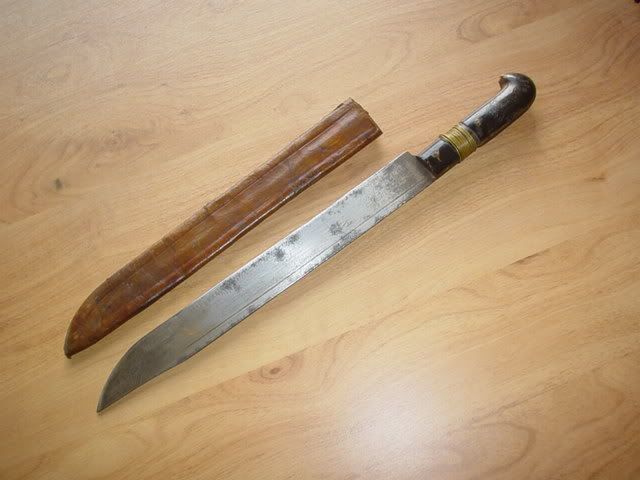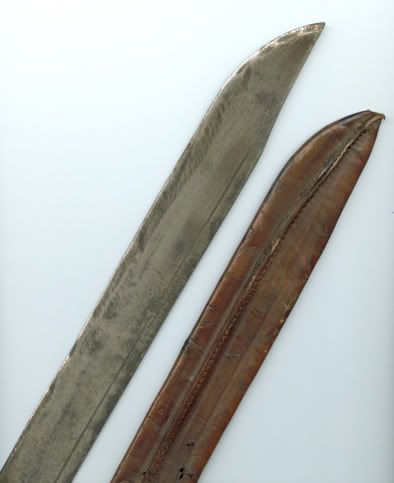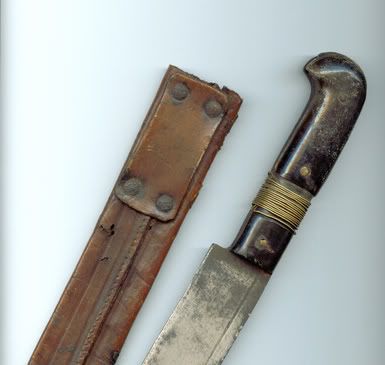
 |
|
|
#1 |
|
(deceased)
Join Date: Dec 2004
Location: Portugal
Posts: 9,694
|
I need help on this one.
The sellers in street fairs are mostly not trustable when it comes to pieces provenances. I was told this is from Papua New Guinea. Is this any plausible ? The blade doesn't look of very high quality, neither very old. The grips are in a natural material, could be horn. The binding is brass wire, and the collar is moulded with thin leather. The sheath is in very thin wood, covered with leather, stitched in one side, fully decorated with tiny superficial efects, having some aplications in straw ( so it looks ). The 12 inch blade is single edged and has a fake fuller in each side. The hanging device is very particular, with part missing. Any coments on this weapon's provenance would be so much wellcome. fernando |
|
|

|
|
|
#2 |
|
Member
Join Date: Dec 2004
Location: Sint-Amandsberg (near Ghent, Belgium)
Posts: 830
|
Interesting. Some time ago I sold a similar knife. I bought it from a man who found it in Congo with the Kongo-tribe when he was working there in the late 50's. He told me it was a hunting knife. It's possible that these knifeblades were traded all over West- and Central-Africa.
The knife itself looks quite similar. Only the sheath differs. I would say your sheath comes from West-Africa (probably Mandingo). The handle on my knife was made of bakelite, I think. Your knife handle looks more like horn. Here are some pics of the knife I had :   
|
|
|

|
|
|
#3 |
|
Member
Join Date: Dec 2004
Location: What is still UK
Posts: 5,806
|
I like these, They are actually quite old 1900s possibly older. The more I read about the Sahel the more interesting and romantic it becomes. A nice find, is it formed from a European knife or do you think it might be of local manufacture? I like the big fat pompom of tassels. The only problem is how dry the leather is. I have a copper bladed knife amonst others from the same region. The leather is so dry I hate to pick it up, but handling is part of the pleasure of collecting. The really dry leather has a strange smell, I can only describe as spicy rather like the smell of curry powder. I like it. The knife that is. I love curry emmmmmmmm

|
|
|

|
|
|
#4 |
|
(deceased)
Join Date: Dec 2004
Location: Portugal
Posts: 9,694
|
Thanks a lot Freddy, right on the spot.
The blade, no doubt, originates from or actually is the same pattern, including the position of the three tang fixation holes. I see some crude marks in the the edge of your ex-piece, maybe a later rustic sharpening. Eventually in my example, the whole blade surface remains integral, and one can see machined marks ( not hand filing ) across the flat and along the fullers, meaning these blades were fabricated in Europe ? Here i go now, searching the web for pictures of a sheath looking like mine ... starting by the Mandingo ... to close the circuit of this example's provenance. Thanks again Hi Tim I don't get your exact meaning for dry leather, my ignorance. The sheath is of thinnest leather and, at looking to the section hidden below the pom pom, the exposed part became darker and more fragile, the type that peels off when you take the price sticker from its face  Is this then defined as dry leather ? The pom pom and stopping knot threads are thicker and flexible, of a more fresh material ... not dry, then ? Despite the different consistences, i wouldn't think the tassel was a later addition, as the sheath hidden tip section has its decoration neglected, as if the artist knew that this part wouldn't be exposed. Is this then defined as dry leather ? The pom pom and stopping knot threads are thicker and flexible, of a more fresh material ... not dry, then ? Despite the different consistences, i wouldn't think the tassel was a later addition, as the sheath hidden tip section has its decoration neglected, as if the artist knew that this part wouldn't be exposed.It's amazing as i may be influenced by the the spicy smell of leather, as you put it, but i can now smell curry when i sniffed the pom pom. I like curry too, my wife makes it good, mainly chicken. Thanks for the age atribution of 1900 or earlier, age of pieces is of primary importance to me. fernando |
|
|

|
 |
|
|